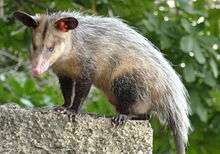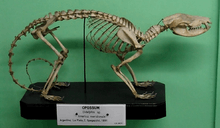Common opossum
| Common opossum[1] | |
|---|---|
 | |
| Scientific classification | |
| Kingdom: | Animalia |
| Phylum: | Chordata |
| Class: | Mammalia |
| Infraclass: | Marsupialia |
| Order: | Didelphimorphia |
| Family: | Didelphidae |
| Subfamily: | Didelphinae |
| Genus: | Didelphis |
| Species: | D. marsupialis |
| Binomial name | |
| Didelphis marsupialis Linnaeus, 1758 | |
 | |
| Common opossum range | |
The common opossum (Didelphis marsupialis), also called the southern or black-eared opossum or gambá,[2] is a mammal species living from the northeast of Mexico to Bolivia (reaching the coast of the South Pacific Ocean to the central coast of Peru), including the Lesser Antilles,[2] where it is called manicou.[3] It prefers the woods, but can also live in fields and cities. The common opossum is sometimes used for food in islands in the West Indies by humans.
Habitat and shelter
This opossum is found in tropical and subtropical forest, both primary and secondary, at altitudes up to 2200 m.[2] They use a wide range of nest sites. Most commonly they will create one in the hollow of a tree; however, they will also dig a burrow or nest in any dark location if nothing else is suitable (which often gets them in trouble with humans).
Description
Physical appearance and weight

The common opossum is similar in size to a house cat. The fur of the opossum is actually yellow in the under-fur, but is hidden by the longer black guard-hairs that cover it, while the tail, fingers, and face are lighter "with the tail being without fur, somewhat similar to a giant rat tail." It can measure nearly 20 inches long. It has large ears that are usually black, and its face is usually a pale peach in color, with black whiskers and eyes that reflect reddish in light. With a body length of nearly a foot, and a tail that can reach almost two feet, the common opossum is one of the larger members of its family. They can weigh in at over three pounds.
Behavior
Their activity is mainly nocturnal and terrestrial, with some arboreal exploration and nesting. Outside of mating they are usually solitary. They are considered pests due to their somewhat raccoon-like behavior. Raiding trash cans, nesting in locations that are not suitable, and causing mayhem if encountered within a human living space, they are often trapped and killed.
Diet
Common opossums have a broad ability to adapt to environmental changes, and their teeth allow them to eat many different types of food, which is obtained mostly on the ground. They can eat small insects, small animals, fruits, vegetables, and also carrion. Their ability to digest almost anything edible gives them a broader range than a human.
Reproduction
The female will have 5-9 offspring between one and three times per year after maturity. The mother raises the young by herself.
Lifespan
The common opossum lives for around 2.5 years.
Classification
They are members the genus Didelphis, which contains the largest American opossums, and the order Didelphimorphia, to which all western hemisphere opossums belong.
References
- ↑ Gardner, A.L. (2005). "Order Didelphimorphia". In Wilson, D.E.; Reeder, D.M. Mammal Species of the World: A Taxonomic and Geographic Reference (3rd ed.). Johns Hopkins University Press. pp. 5–6. ISBN 978-0-8018-8221-0. OCLC 62265494.
- 1 2 3 4 Brito, D.; Astua de Moraes, D.; Lew, D.; Soriano, P.; Emmons, L.; Cuarón, A. D.; Helgen, K.; Reid, R. & Vazquez, E. (2008). "Didelphis marsupialis". IUCN Red List of Threatened Species. Version 2008. International Union for Conservation of Nature. Retrieved 28 December 2008.
- ↑ "Checklist of Mammals of Trinidad and Tobago". Republic of Trinidad and Tobago Biodiversity Clearing House. 2005. Retrieved 2010-10-24.
